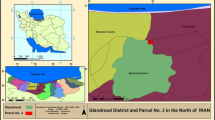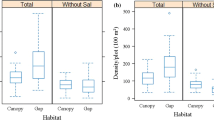Abstract
The bamboo Fargesia nitida, one of the giant panda’s main food sources and the dominant shrub species of the forest understory, is mainly distributed in the dark coniferous belt in western Sichuan and southern Gansu in China. To study the impact of different forest canopy conditions on subalpine dwarf bamboo populations, ramet population structures of clonal Fargesia nitida were surveyed in: forest understory (FU), moderate gap (MG), large gap (LG) and marginal open space (MOS). In order to determine how the ramet structures could be affected and its effects on these four canopy conditions, a field survey of the age structure of Fargesia nitida population, its morphological traits and biomass was conducted in the Abies faxoniana forest situated in the Wolong Nature Reserve, western Sichuan, China. The main results were as follows. First, at the ramet level, the structures of the ramet populations in four canopy conditions were significantly different, and as the canopy density decreased, the mean height, basal diameter and biomass of the populations increased following the order: LG<MG<FU. Second, the biomass proportions of ramets modularly varied with different canopy conditions and leaf biomass proportion was positively related to the canopy density except for the MOS where the biomass proportions of rhizome and roots were both higher than those in the three other canopy conditions. Third, ramet specific leaf weight increased in parallel with the decrease in canopy density. In the MG, the values of the individual leaf biomass and leaf area were the largest, followed by those in the MOS. Both the individual leaf biomass and leaf area were significantly different from those in the FU and LG. Leaf number per ramet was significantly different among the four different canopy conditions and the biggest in the LG. Fourth, the ramet population mortality was the lowest in the FU (Chi-square test, p < 0.01), while there was no significant difference in the average population age (Mann-Whitney test, p > 0.05). All the results indicated that it was not ramet age, but the morphological changes and biomass distribution that exhibited the response of the ramet population of Fargesia nitida to the changed canopy conditions.
Similar content being viewed by others
References
Chen J S, Dong M, Yu D, Liu Q (2004). Clonal architecture and ramet population characteristics of Lysimachia congestiflora growing under different light conditions. Chin J Appl Ecol, 15(8): 1,383–1,388 (in Chinese)
de Kroon H, Schicving F (1991). Resource allocation pattern as a function of clonal morphology: A general model applied to foraging clonal plant. J Ecol, 79(2): 519–530
Denslow J S, Ellison A M, Sanford R E (1998). Treefall gap size effects on above-and below-ground process in a tropical wet forest. J Ecol, 86(4): 597–609
Denslow J S, Schultz J C, Vitousek P M, Boyd R (1990). Growth responses of tropical shrubs to treefall gap environments. Ecology, 71(1): 165–179
Editorial Board of Forests in Sichuan (1992). Forests in Sichuan. Beijing: China Forestry Press, 703–708
Flora of China Editor Commission (1996). Flora of China (Vol. 9). Beijing: Science Press, 428–431 (in Chinese)
He W M, Zhong Z C (2000). Morphological and growth responses of the climbing plant, Gynostemma pentaphyllum seedlings to varying light intensity. Acta Phytoecol Sin, 24(3): 375–378 (in Chinese)
Hiura T, Sano J, Konno Y (1996). Age structure and fine-sale disturbance of Abies sachalinensis, Picea glehnii and Butala ermanii growing under the influences of a dwarf bamboo understorey in North Japan. Can J For Res, 26(2): 287–297
Li J C, Su S M, Li W H (1995). Effect of light intensity on the plant growth in H. citrina. Acta Bot Boreal-Occident Sin, 15(1): 78–81 (in Chinese)
Liu Q, Li Y X, Zhong Z C (2004). Effects of moisture availability on clonal growth in bamboo Pleioblastus maculata. Plant Ecol, 173(1): 107–113 (in Chinese)
Li Z X, Zheng H, Ouyang Z Y, Wang X K, Liu X L, Su Y M (2004). The spatial distribution characteristics of throughfall under Abies faxoniana forest in the Wolong Nature Reserve. Acta Ecol Sin, 24(5): 1,015–1,021 (in Chinese)
Liu Q, Wu Y, He H (2001). Ecological problems of subalpine coniferous forest in the southwest of China, World Sci Tech Res Dev, 23(2): 63–69 (in Chinese)
Qin Z S, Taylor A H, Cai X S (1993). Bamboo and Forest Dynamic Succession in the Ecological Environment of Giant Panda in Wolong. Beijing: China Forestry Press, 13, 37–39, 52–57, 149–156, 170–210, 245–318 (in Chinese)
Qi Z M, Wang K Y, Yang W Q, Song G Y (2004). Ecological studies on bamboo (Fargesia) communities. World Sci Tech Res Dev, 2004, 26(1): 73–78 (in Chinese)
Tabarelli M, Mantovani W (2000). Gap-phase regeneration in a tropical montane forest: The effects of gap structure and bamboo species. Plant Ecol, 148(2): 149–155
Taylor A H, Qin Z S, Liu J (1995). Tree regeneration in all Abies faxoniana forest after bamboo diebaek, Wanglang Natural Reserve. Chin-Can J For Res, 25(12): 2,034–2,039
Taylor A H, Qin Z S, Liu J (1996). The structure and dynamics of subalpine forest in the Wanglang Natural Reserve, China. Vegetatio, 124(1): 25–38
Uhl C, Clark K, Dezzeo N, Maquirino P (1988). Vegetation dynamics in Amazonian treefall gaps. Ecology, 69(3): 751–763
van der Meer P J, Sterek F J, Bongers F (1998). Tree seedling performance in canopy gaps in a tropical rain forest at Nouragues, French Guiana. J Trop Ecol, 14(2): 119–137
Wang J X, Ma Z G (1993). Ecological Studies on Giant Panda’s Main Bamboos. Chengdu: Sichuan Scientific and Technical Press, 62–87 (in Chinese)
Widmer Y (1998). Pattern and performance understory bamboos (Chusquea spp.) under different canopy bamboos closures in old-growth oak forest in Costa Rica. Biotropica, 30(3): 400–415
Wang W, Tao J P, Li Z F, Zhang W Y, Ding Y (2004). Gap features of subalpine dark coniferous forest in Wolong Nature Reserve. Chin J Appl Ecol, 15(11): 1,989–1,993
Wei F W, Feng Z J (1999). Association between environmental factors and growth of bamboo species Bashania spanmtachya, the food of giant and red pandas. Acta Ecol Sin, 19(5): 710–714 (in Chinese)
Zhang W H, Wang Y P, Kang Y X, Liu X J (2004). Study on the relationship between Larix chinensis population’s structure and environment factors. Acta Ecol Sin, 24(1): 41–47 (in Chinese)
Zhang W Y, Wang B S, Li M G, Zan Q J, Wang Y J (2002). The effects of light intensity on growth and morphology in Mikania miernatha Seedlings. Sun Yatsen Univ Forum, 22(1): 222–226 (in Chinese)
Zhong Z C (1995). Reproductive strategies of plant populations. Chin J Ecol, 14(1): 37–42 (in Chinese)
Author information
Authors and Affiliations
Corresponding author
Additional information
Translated from Acta Ecologica Sinica, 2006, 40(1): 730–736 [译自: 生态学报]
About this article
Cite this article
Tao, J., Song, L., Li, Y. et al. Ramet population structure of Fargesia nitida in different canopy conditions of the subalpine dark coniferous forest in the Wolong Nature Reserve, China. Front. Forest. China 2, 278–283 (2007). https://doi.org/10.1007/s11461-007-0045-9
Issue Date:
DOI: https://doi.org/10.1007/s11461-007-0045-9




